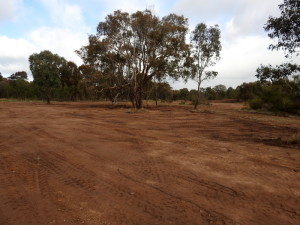Extension of the Euroa golf course? New Euroa Airport site? These are some of the ideas the community has raised to explain the recent ‘landscape’ changes at the Euroa Arboretum. Last week a section of grassland at the Arb was scalped (see photo below)—that is, it had a whole layer of topsoil removed along with the introduced perennial grasses and weeds. And the reason? It is the latest project by Cathy Olive, Project Coordinator at the Arb, to ‘bring back the bush’, using a process pioneered by Dr Paul Gibson Roy from Greening Australia.

Restoring grassy woodlands to their original glory is not easy for a couple of reasons. First, farmers traditionally have applied phosphorus and nitrogen fertiliser to increase the productivity of the land. But native plants prefer low phosphorus and nitrogen in their soil. Second, native grasses and groundcovers struggle to compete with exotic grasses. This is especially a problem because many of these grasses have built a ‘seed bank’ in the soil. And rather than die off once poisoned, these seeds will sprout for many years. As this site was almost entirely dominated by introduced perennial grasses, scalping and subsequent re-seeding was deemed the best technique for restoring the native groundcover diversity.
One way to get rid of the fertiliser and exotic grass seeds is simply to get rid of the top layer of soil. At the Arb, we did some tests at various soil depths and found that removing of 10 cm of topsoil effectively removed the seed bank and left low phosphorus and nitrogen concentrations, which native grasses prefer.

So last week that is what happened. A grader scalped 10 centimetres of soil from a 1.1 hectare site at the Arboretum. The removed soil was piled into two heaps, which we have affectionately named Mt Arb and Little Mt Arb—at 2.5 metres these are the highest landforms around for miles and would have afforded unparalleled views across the Sevens Creek floodplain if the Arb people hadn’t planted all those trees in the way. The mounds provide smaller, more manageable areas to control the exotic grasses and weeds which will no doubt still germinate. In some parts of the scalped area, Onion Grass (Romulea rosea) corms in particular are obvious (see photo below). Some more scalping will be needed to remove these.

So what’s next? The scalped site will be planted with seed from at least 50 species of native grasses, groundcovers and shrubs using a direct seeding device operated by Greening Australia. ‘Photo points’ will be set up from which we will periodically take photos to assess how this latest trial is going. And of course we will compare the growth in the scalped and reseeded site with an equivalent untouched site immediately next door.
Who knew that the Arb vision of ‘bringing back the bush’ would involve a bit of ‘bulldozing the weeds and soil’?

